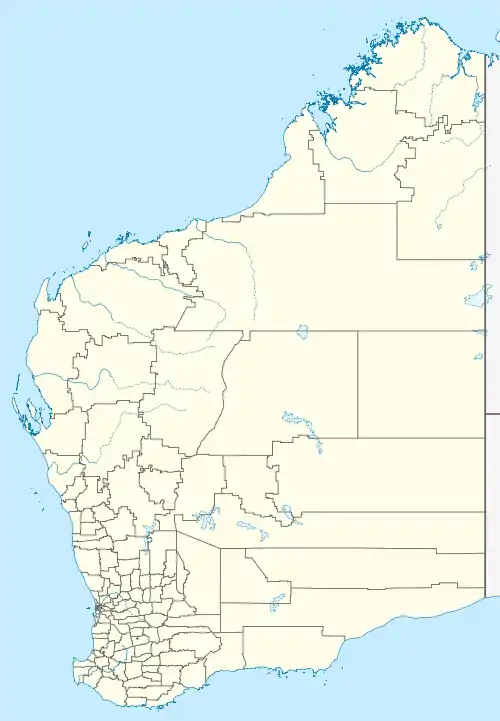Port Walcott
Port Walcott is a large open water harbour located on the northwest coast of Western Australia, located near the town of Point Samson.[1] It contains the port facilities of Cape Lambert, which along with the neighboring ports at Port Hedland and Dampier, are the three major iron ore exporting ports in the Pilbara region,[2] and in the top five ports in Australia by tonnage (81 million tonnes in 2010/11).[3]
| Port Walcott Western Australia | |||||||||
|---|---|---|---|---|---|---|---|---|---|
 Port Walcott | |||||||||
| Coordinates | 20°39′S 117°12′E | ||||||||
| Established | 1960s | ||||||||
| Location | 38 km (24 mi) from Karratha | ||||||||
| State electorate(s) | North West | ||||||||
| Federal division(s) | Durack | ||||||||
| |||||||||
Geography
Port Walcott's main population centre is Point Samson, which has a population of 298 (2011 census).[4] Port Walcott receives an annual rainfall of about 295 mm. The most rain received by Port Walcott in a day was 336 mm.
Port Walcott lies between Dampier and Port Hedland at the mouth of the Harding River. Landmarks within it include Cape Lambert, Wickham, Jarman Island, Butchers Inlet and the historical town of Cossack (initially called Tien Tsin), the first port in the northwest of Western Australia. The town of Roebourne is situated further inland on the banks of the Harding River.[5]
History
Early European exploration of northwest Western Australia commenced around the Nickol Bay and Port Walcott areas, as colonial settlers established pastoral and pearling industries in the late-19th century. Early shipping links to the outside world centred on the port of Cossack (Tien Tsin), now a ghost town.
In 1818, the explorer and surveyor Captain Phillip Parker King, in the Mermaid, charted Nickol Bay. Visits to the region by American whalers are recorded to have occurred from around the 1840–50s. In April 1861, a government-funded expedition sailed to Nickol Bay in the Dolphin, while in 1862, Bateman (of John and Walter Bateman) sent his vessel Flying Foam to harvest pearl shell in the area. In April 1863 Captain Peter Hedland on the Mystery discovered Mangrove Harbour (later named Port Hedland) and Captain John Jarman on the Tien Tsin discovered Tien Tsin Harbour (later named Port Walcott).
Later the same year the Mystery and the Tien Tsin[6] brought settlers and stock, and established the first European settlement in the northwest, on the banks of the Harding River, inland from Tien Tsin Harbour.[7][8]
Other information
- Local magnetic anomalies are reported northward of Cape Lambert, in the approaches to Port Walcott[9]
- The Norwegian-owned iron barque Solveig carrying jarrah piles for the Point Samson jetty was anchored in Port Walcott when it was wrecked during a cyclone in 1907[10] The Department of Maritime Archaeology lists 14 such shipwrecks in the vicinity, lost between 1868 and 1970.
- The bulk carrier "Hanjin Port Walcott" was named after Port Walcott.[11]
References
- Port handbook – Port Walcott (PDF). Port Walcott: Rio Tinto. 1 July 2016. Retrieved 13 September 2018.
- Annual report 2015 – Pilbara ports authority. Port Hedland: PPA (Pilbara ports authority). 1 May 2016. Retrieved 1 June 2017.
- of Western Australia, The State Government (2012). Ports Handbook – Western Australia (PDF). Department of Transport. p. 34.
- Australian Bureau of Statistics (31 October 2012). "Point Samson (Urban Centre/Locality)". 2011 Census QuickStats. Retrieved 19 February 2015.
- Anderson, Ross; Green, Jeremy (2011). Anketell Port Development – Maritime and Underwater Cultural Heritage (MUCH) desktop analysis (PDF). Australia: Department of Maritime Archaeology, Western Australian Museum. p. 3.
- "Shipping Intelligence". The Inquirer And Commercial News. Vol. XXII, no. 1, 176. Western Australia. 19 August 1863. p. 2. Retrieved 18 October 2018 – via National Library of Australia.
- McMarthy, Michael (Mack) (1990). Charles Edward Broadhurst (1826–1905): a remarkable nineteenth century failure (PDF). Murdoch University. pp. 30–49. Retrieved 2 May 2017.
- Nayton, Gaye (2011). "The Archaeology of Market Capitalism: A Western Australian Perspective". Contributions to Global Historical Archaeology. Springer Science & Business Media: 77. ISBN 9781441983183. ISSN 1574-0439. Retrieved 2 May 2017.
- Australia Pilot. HMSO. 1959. p. 31.
- S, Sledge (1978). Wreck Inspection North Coast (WINC) expedition 1978: report of investigation of shipwreck and historic sites along the north and northwest coasts of Western Australia, June–September 1978. Western Australian Museum: Department of Maritime Archaeology, No. 11. p. 17.
- "Hanjin – Bulk Vessel Fleet". Retrieved 22 August 2013.